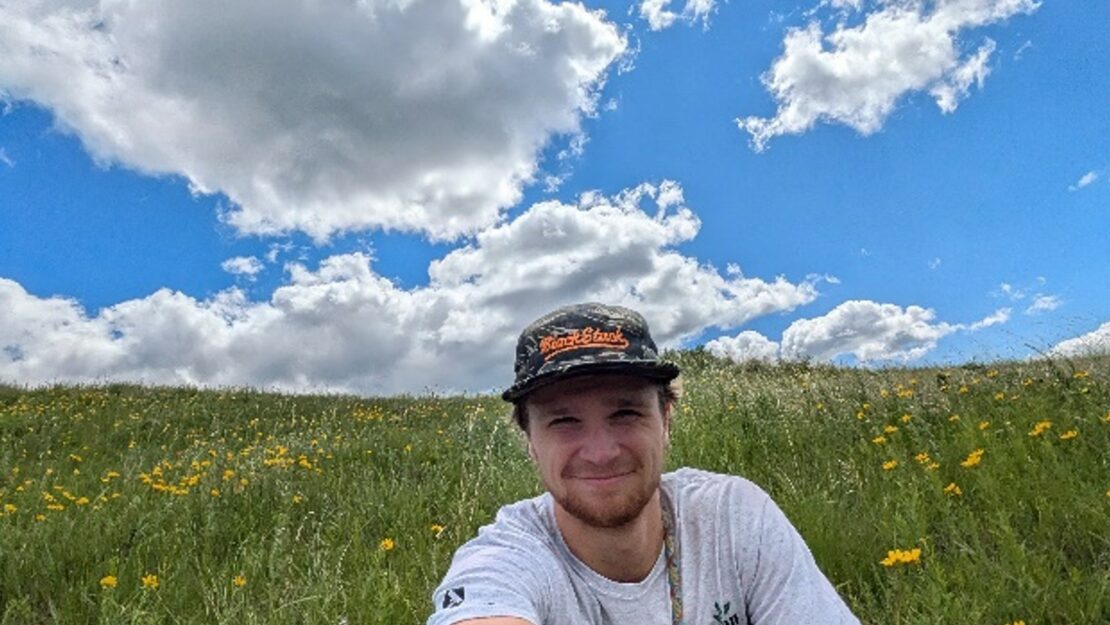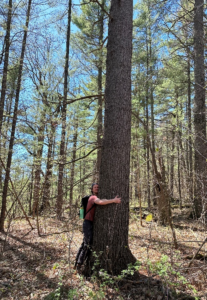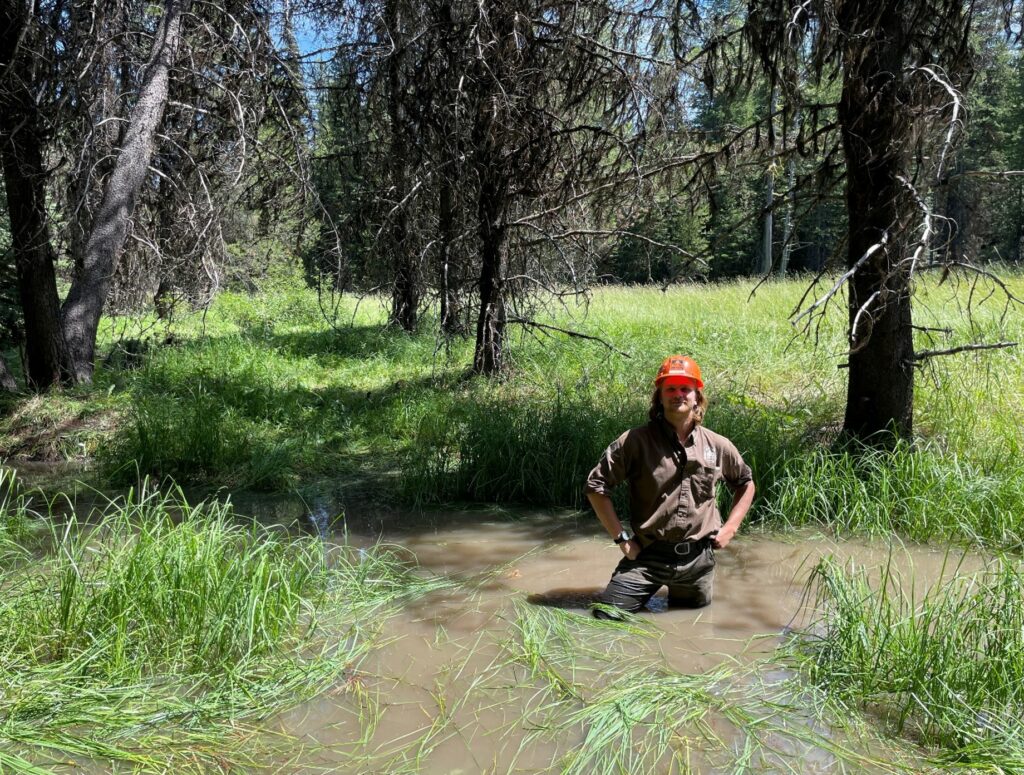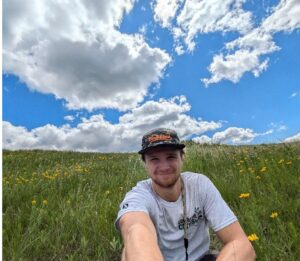Individual Placement Spotlight Series: Justin Vorndran

By Jesse Wolk, Utility Mapping Specialist Individual Placement / AmeriCorps Member placed at Minnesota Department of Natural Resources, Division of Parks and Trails
VI: Semantics
The Individual Placement (I.P.) Spotlight Blog is a series of interviews between Jesse Wolk and his fellow I.P. members. The goal of the series is to highlight their unique positions, projects, and backgrounds while simultaneously reflecting on their service term in the context of the Natural Resources career field in Minnesota. In the sixth edition of the series, Semantics, the spotlight is shifted to our Scientific and Natural Areas (SNA) Communication and Outreach Specialist – Justin Vorndran!
There is a lot of confusion on the difference between the actions, “conservation” and “natural resource management”. As far as I can tell, the former protects ecosystems from human activity while the latter attempts to sustainably extract resources from those very same systems. Today, the practices are so tightly woven that they are often used interchangeably, hence the confusion. However, historically, these two ideas were radically far apart. Look no further than Minnesota for a quick case study.
From about 1870-1930, the Minnesota logging industry sawed through its timber. Loggers cut down almost all the valuable trees in the state in those short 60 years. While many most certainly recognized how unsustainable the practices were, it didn’t really matter. There was strong demand and little regulation. Today, only a fraction of Minnesota’s old growth forest remains. The resource was extracted without much thought for its future in Minnesota.
In the colonization of the United States by European settlers, this was the modus operandi. Extract the resource as cheaply as possible and by whatever means necessary. The negative externalities that were incurred, like The Great Hinckley Fire or loss of biodiversity, were simply the price to pay for economic development. This was the United States’ very first, and favorite, method of natural resource management. In the beginning of the 20th century, to many of the descendants of those very same European settlers, it quickly became apparent that annihilation was simply was not sustainable.
A movement had begun, and as a result, conservation quickly became the backbone of natural resource management. Land management organizations were developed by all levels of government to begin sustainably extracting, and protecting, the resources within their jurisdiction. Organizations, like Minnesota’s Department of Natural Resources (DNR), state this sentiment in their mission today. For this dichotomous task to be accomplished, they must balance two opposing interests: to continue to extract resources from the land, but also to protect the valuable remaining natural places from development.

Justin Vorndran documents one of the ways in which the DNR acts as a pulley in resource protection. The DNR’s Scientific and Natural Area (SNA) program protects modest parcels of land to give a space for scientists to study the rare species and systems in which they thrive. Unlike state parks, there is no development in SNAs – camping, campfires, and foraging are not allowed. They function, “to perpetuate the state’s ecological and geological diversity.” As far as Justin is concerned, that’s a noble goal worth working towards.
Justin grew up in Osceola, Wisconsin which borders the St. Croix National Scenic Riverway near Interstate State Park. As a child, Justin’s mom would take him to naturalist activities at Interstate State Park where he discovered a passion for the outdoors. Naturally, this passion transitioned into action where, in high school, he spent time leading restoration events with Standing Cedars Land Conservancy, a community nonprofit protecting remnant prairie near the St. Croix River. At St. Olaf college, followed these passions, and studied English with minors in Environmental Studies and Media Studies and graduated in the spring of 2023.
During one of his summers in college, Justin served in a Conservation Field Crew completing restoration and maintenance projects in Oregon, which was a formative experience. His favorite memory was a stream restoration project with Trout Unlimited where him and his crew built beaver dam analogs to un-channelize a stream. Justin told me that this project really stuck out to him because he got to witness it improve the health of the wetland that day. This experience sparked Justin’s passion for projects that focus on ecological restoration and directed his career goals to finding a position that worked on them.

Once Justin graduated, Justin had thought that his passion for restoration work and communications belonged to separate career paths. This changed when he found the Outreach and Communications I.P. position within the SNA program. “Shocked;” Justin realized that “skills that (he) thought weren’t conservation skills were really valuable.” Today, Justin’s main goal is to, “tell stories about the SNA program.” Mainly, this is done through the SNA’s Facebook page where Justin showcases events, goals, and land management actions of the 170 sites within the program.

Essentially, Justin is attempting to get the public to care about a program within the DNR that only indirectly serves them. SNAs are not state parks, or state recreation areas. They are not designed for humans to easily visit but rather for humans to be hardy visitors. Whether its managing the Facebook page, writing a quarterly newsletter, performing website maintenance, or conducting media management for events, Justin engages the public by promoting the amazing biodiversity and ecosystem services that these natural areas offer us. Justin plays a key role in communicating the importance of conserving land in the grand scheme resource management.
Promoting conservation has been a joy for Justin, but it’s been quite the learning curve. As Justin told me, successful conservation communications need to come from a “sound ecological background”, which has meant that he spends a lot of time researching and learning new things about natural places. Additionally, learning the process of representing a state agency on social media is its own challenge. To overcome these hurdles, through the I.P. training budget, Justin took a continuing education class at the Minneapolis College of Arts and Design on visual branding and graphic design along with a class through the Minnesota Council of Nonprofits on grant writing.
Reflecting on his year, Justin has enjoyed blending his skills in communications with his passion for conservation. He notes that he has enjoyed sharing his experiences with his fellow I.P. members who all seem to be, “charting their own paths together”. Finally, he expressed gratitude that this experience has allowed him to get materials to build out a portfolio for future positions and hopes he can find a similar position within the DNR soon.
Resource management is very complicated. Every resource manager understands that harsher methods of resource extraction, like mining or logging, must occur to provide the standard of living that we all enjoy. Ideally, this occurs with minimal impact to the ecosystem. Unfortunately, unforeseen, or ignored, impact frequently occurs. This is part of what makes places like SNAs important because they typically escape those destructive impacts and offer their ecosystem services like opportunities for bountiful research, low-impact recreation, and solitude. Communicating their importance to the public is critical, because without the public’s support, they wouldn’t exist. Hopefully, Justin’s work will maintain that connection and in turn, continue to confuse the increasingly semantic difference between conservation and natural resource management.
Thanks for reading and catch you in a few weeks!
– Jesse Wolk